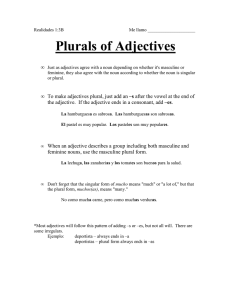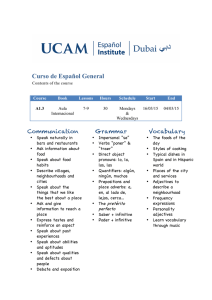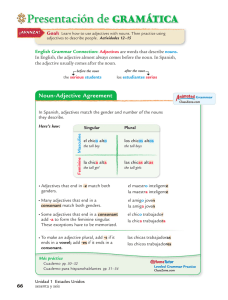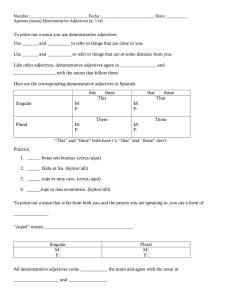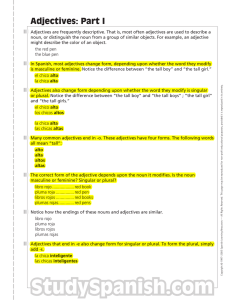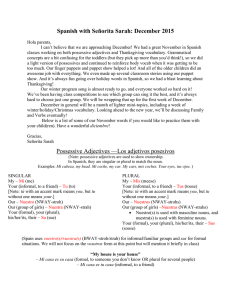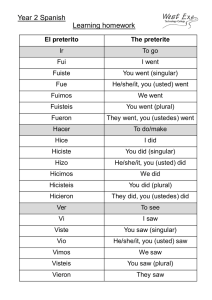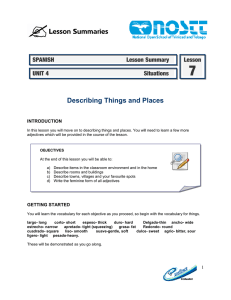Lesson 48 Notes
Anuncio
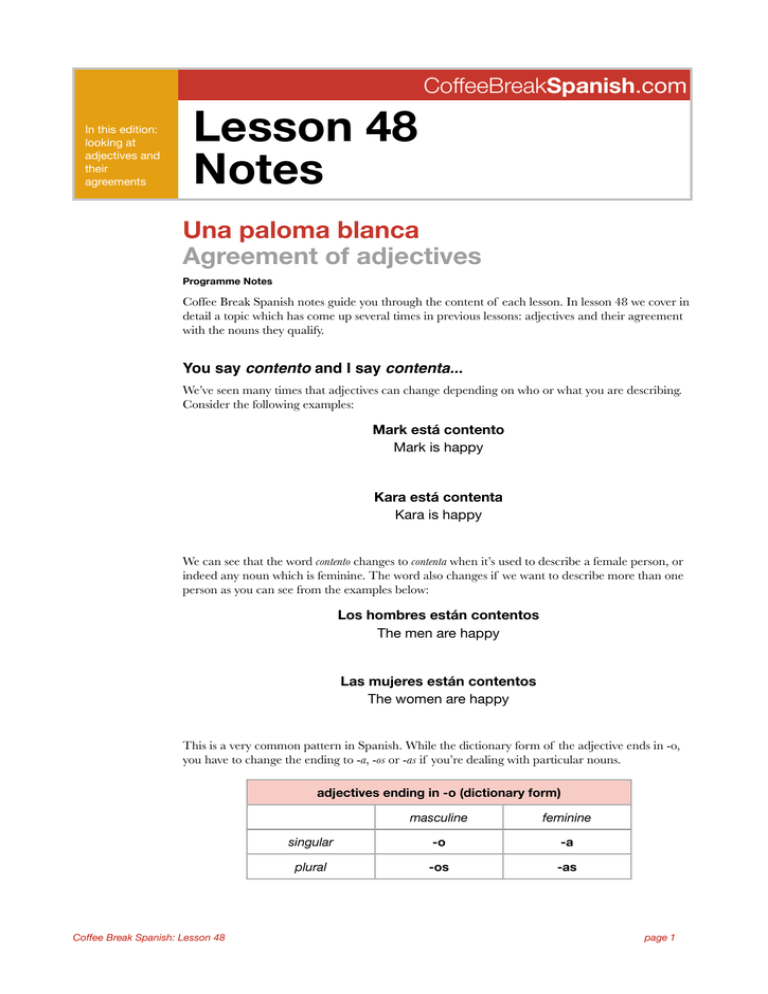
CoffeeBreakSpanish.com In this edition: looking at adjectives and their agreements Lesson 48 Notes Una paloma blanca Agreement of adjectives Programme Notes Coffee Break Spanish notes guide you through the content of each lesson. In lesson 48 we cover in detail a topic which has come up several times in previous lessons: adjectives and their agreement with the nouns they qualify. You say contento and I say contenta... We’ve seen many times that adjectives can change depending on who or what you are describing. Consider the following examples: Mark está contento Mark is happy Kara está contenta Kara is happy We can see that the word contento changes to contenta when it’s used to describe a female person, or indeed any noun which is feminine. The word also changes if we want to describe more than one person as you can see from the examples below: Los hombres están contentos The men are happy Las mujeres están contentos The women are happy This is a very common pattern in Spanish. While the dictionary form of the adjective ends in -o, you have to change the ending to -a, -os or -as if you’re dealing with particular nouns. adjectives ending in -o (dictionary form) Coffee Break Spanish: Lesson 48 masculine feminine singular -o -a plural -os -as page 1 One important point to mention is that when you are talking about a group of male and female people you must use the masculine plural form, even if there is just one male and many females. Consider the following examples: Mark y Kara están contentos Mark and Kara are happy Mi hijo y mis nueve hijas están contentos My son and my nine daughters are happy Even where there are nine daughters and only one son in the second example, the masculine plural form of the adjective is used. Let’s consider two other adjectives: “black”, negro, and “white”, blanco. negro (black) • blanco (white) masculine feminine singular negro • blanco negra • blanca plural negros • blancos negras • blancas This gives rise to the following examples: examples of negro masc singular el libro negro the black book fem singular la casa negra the black house masc plural los gatos negros the black cats las camisas negras the black shirts fem plural examples of blanco masc singular el gato blanco the white cat fem singular la paloma blanca the white dove masc plural los zapatos blancos the white shoes las mesas blancas the white tables fem plural Adjectives ending in -e Some adjectives end in -e in the singular. They have the same form for both masculine and feminine nouns. In the plural the ending becomes -es. Examples include importante, inteligente, interesante, etc. Look at the table below for the adjective endings and examples using importante. Once again, you’ll find that the dictionary form of these adjectives ends in -e, but you have to add an -s if you’re dealing with a plural noun. Coffee Break Spanish: Lesson 48 page 2 adjectives ending in -e (dictionary form) masculine feminine singular -e -e plural -es -es examples of inteligente masc singular el hombre inteligente the clever man fem singular la ciudad importante the important town masc plural los libros interesantes the interesting books fem plural las niñas inteligentes the clever girls Other adjectives Some adjectives do not end in -o or -e in their dictionary forms. We’ve already come across a number of these: consider the adjectives used for describing nationalities. The table below shows the main patterns which you should learn, using some common adjectives. Example adjectives ending in consonants m. sing. f. sing. m. plur. f. plur. translation español española españoles españolas Spanish inglés inglesa ingleses inglesas English francés francesa franceses francesas French alemán alemana alemanes alemanas German japonés japonesa japoneses japonesas Japanese trabajador trabajadora trabajadores trabajadoras hard-working charlatán charlatana charlatanes charlatanas talkative We learned earlier that adjectives ending in -e in their dictionary form take the -es ending in the plural. There are also some adjectives which end in consonants and which have the same form for both masculine and feminine singular. Here are some examples: Example adjectives with same masc and fem forms m. sing. f. sing. m. plur. f. plur. translation azul azul azules azules blue difícil difícil difíciles difíciles difficult fácil fácil fáciles fáciles easy feliz* feliz felices* felices* happy natural natural naturales naturales natural Coffee Break Spanish: Lesson 48 page 3 Towards the end of lesson 48 we learned a number of adjectives used to describe people. Adjectives used to describe physical characteristics of people m. sing. f. sing. m. plur. f. plur. translation alto alta altos altas tall bajo baja bajos bajas small delgado delgada delgados delgadas slim gordo gorda gordos gordas fat moreno morena morenos morenas dark-haired, dark-skinned rubio rubia rubios rubias fair-haired guapo guapa guapos guapas good-looking feo fea feos feas ugly Position of adjectives You will already have noticed that in most cases, adjectives come after the noun in Spanish: el hombre inteligente the intelligent man la casa pequeña the small house There are some situations where adjectives come after the noun, but these will be covered in future lessons. ©Copyright Radio Lingua Ltd 2008 Coffee Break Spanish: Lesson 48 page 4
